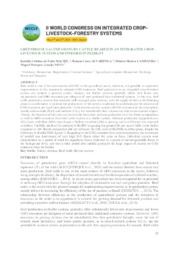Greenhouse gas emissions by cattle reared in an integrated croplivestock system and finished in feedlot.
Greenhouse gas emissions by cattle reared in an integrated croplivestock system and finished in feedlot.
Author(s): MACIEL, I. C. de F.; ALVARENGA, R. C.; CAMPANHA, M. M.; GONTIJO NETO, M. M.
Summary: Beef cattle is one of the main sources of GHG in the agricultural sector, however, it is possible to implement improvements in this segment to mitigate GHG emissions. Beef production in an integrated crop-livestock system can achieve a positive carbon balance, but feedlot systems generally offers both lower area requirements and GHG emissions per kilogram of meat produced than traditional systems. In this way, beef cattle production systems that associate well-managed grass systems, with the supply of diets in the finishing phase is an alternative to increase the productivity of the system, in addition to contributing to the reduction of GHG emissions per kg of meat produced. Cattle excreta are also sources of GHG emissions to the atmosphere, mainly nitrous oxide (N2O) and methane (CH4), but considerably less is known on their environmental impact. Thence, the objective of the study was to evaluate the enteric methane production from two breed compositions as well as GHG emissions from beef cattle excreta in a feedlot system. Methane production (kg/period) was 19% lower in Nellore (NEL) than Angus x Nellore crossbred (AN) in grazing, and no difference was observed in feedlot. The NEL had less CH4 intensity (CH4/BW) in grazing but greater CH4 per unit of ADG in the feedlot compared to AN. Breed composition did not influence the CH4 yield (CH4/DMI) in either phase, despite the difference in feedlot DMI (kg day-¹). Regarding to the GHG emission from excreta deposition, the occurrence of rainfall was determinant of very high N2O fluxes either for urine or feces. Individual excreta were characterized by a period of small but significant fluxes, followed by a period of indistinguishable fluxes at the background level, and then a third period after rainfall portrayed the large impact of excreta on GHG emissions from the feedlot.
Publication year: 2021
Types of publication: Paper in annals and proceedings
Unit: Embrapa Maize & Sorghum
Keywords: Beef cattle, Bovine excreta, Excreta bovina, Fezes, Gado de Corte, Metano, Metano entérico, Methane
Observation
Some of Embrapa's publications are published as ePub files. To read them, use or download one of the following free software options to your computer or mobile device. Android: Google Play Books; IOS: iBooks; Windows and Linux: Calibre.
Access other publications
Access the Agricultural Research Database (BDPA) to consult Embrapa's full library collection and records.
Visit Embrapa Bookstore to purchase books and other publications sold by Embrapa.

